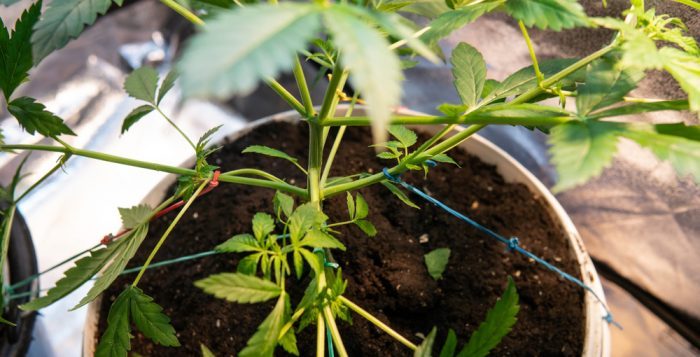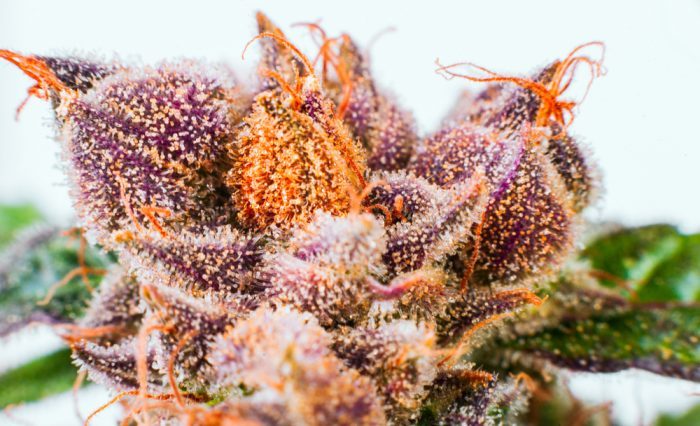Use these tips on grow techniques to create the best results from your home grow.
Anyone who grows their own medicine starts out with big dreams. Common fantasies include: thick canopies and happy plants gently swaying as frosted nugs glisten under a grow light. Most home growers know however, that things usually turn out quite differently. Growing high-quality cannabis is difficult and takes practice and mentorship. But with a few simple grow techniques, you’ll soon be growing those high-yielding plants with the thick dense nugs we all dream of cultivating.
It’s time to get to the hardware store, pick up a few tools, get down on your hands and knees, and start talking to those plants! Here are our top grow techniques to fatten up those buds before harvest.
Selective Defoliation: Redirecting Nature
The process of trimming leaves from your cannabis plant is known as defoliation. As one of the most common grow techniques, its main purpose is to help the plant divert its precious energy into forming dense buds higher up where there is abundant light.

It’s the leaves of a plant that convert light into energy via a process known as photosynthesis. When it comes to cannabis plants, you’ll want to remove those leaves that are directing energy to parts of the plant where little light penetrates. These are low down under the canopy.
Studies have analyzed the redistribution of nutrients within a plant after defoliation. They have demonstrated that many types of plants are extremely flexible in responding to stress and reallocating resources. The cannabis plant is one of these. Buds that form at the bottom of the plant often end up becoming what are known as popcorn buds. These small, low-quality B-grade buds aren’t what you want from your homegrown medicine. Through the process of selective defoliation you prevent popcorn buds from developing by harnessing the plant’s energy in the most efficient way.
To defoliate, remove the larger leaves that fan out from stems that aren’t connected to a bud site. By cutting off the energy supply, you ensure the plant gives up on developing this bud-less area. This will also help light penetrate through the canopy, as well as increase airflow. Both of these help ensure even quality bud throughout. In addition, increased airflow decreases humidity levels, which is crucial for later flowering.
The best time to defoliate is during early flowering. This allows the plants to then bounce back and proceed through the remainder of the flowering cycle, stress-free.
Low-Stress Training (LST): The King of Grow Techniques
This process involves manipulating the plant structure for optimal growth. Without stress training, a cannabis plant will grow one large cola with a handful of small nugs. It’ll end up looking something like a Christmas tree, and that’s not what you want.
[embedyt] https://www.youtube.com/watch?v=4DBdNw49cUs[/embedyt]To stress train your plants, you’ll need to drill a small hole in the side of your pot and pass a wire through. The wire should be gently wrapped around the stem to bend it slightly toward the outside. In the following hours and days, you should begin to notice the lower branches extend upward to the same height as the main top. The training process continues by bending the plant at ever increasing increments every second day around the circumference of the pot.
It’s best to have completed the entire training process by preflower, as this is when the plant begins to stretch. Moreover, the branches of the plant are much more flexible early on in their maturity cycle. Once flowering is in full bloom, the branches become stiff, and are prone to snapping.
If LST is done correctly, then several colas populated with large dense buds, will begin to reach upward. Many argue that low-stress training is the most effective grow technique for ensuring a high-yielding plant with supreme quality buds. After all, if you’re restricted in the number of plants you can grow, you want to make the most of it.
The only downside of this grow technique is the time it takes to do it properly. If you have a large grow, then it can become time-consuming. But with the right attitude, or even by consuming a little of the plant you’re working with, it can quickly become a meditative experience!
The Scrog Method: Fatten Up those Nugs
Short for “screen of green”, the scrog method involves using trellis nets to automate the low-stress training technique. It involves placing a net with large holes over the plants to offer support. It guarantees an even canopy as all stems are held at the same height right under the net. For those with a larger grow, it results in considerable time savings when compared to tying stems individually.

This grow technique encourages the plant to grow horizontally. This means that it utilizes both lighting and grow space extremely efficiently. During the flowering cycle the stems grow above the canopy and the buds have ample room to fatten up. And because they all start from the same place, they all grow evenly.
It’s important to defoliate beneath the canopy as little light will reach these areas. You don’t want the plant investing energy into what will end up as popcorn buds. Defoliating also helps prevent mold and mildew formation – important factors if you want to keep your medicine free from contaminants that could devalue its benefits.
Temperature and Humidity Control
When it comes to yield and bud quality, temperature and humidity are important considerations.
High temperatures produce loose buds, while cooler temperatures produce dense buds. High humidity results in diminished nutrient uptake, while with low humidity, protective elements within the plant struggle to offset the lack of moisture. This results in diminished yields or even a dead plant.
During the flowering process, you should be aiming for temperatures in the range of 70-75°F (21-23°C). For relative humidity, aim for 40-45 percent.
Install digital sensors that measure both temperature and humidity in your grow room for optimal control. For those who have the budget, an air conditioning unit and dehumidifier provide the best mechanism of control. Failing either, draw in air from outside by leading ducting into the grow space. Well-positioned oscillating fans and lights can then help maintain optimal conditions.

To control humidity without a dehumidifier, ensure there’s no standing water in the drainage trays. This water will evaporate in time and increase humidity levels in the grow area. Defoliation and the spacing of plants are also important when it comes to controlling humidity. Many growers report a 10 percent decrease in relative humidity after this.
Maybe you’ve just spent money on a dehumidifier and nets, or perhaps you did go to the hardware store and are down on your hands and knees pruning. Either way, we hope the aforementioned tips help add a sparkle to your buds under them grow lights! Share your photos and stories of your own home grow techniques in the comments below!





